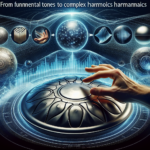<!DOCTYPE html>
<html lang="en">
<head>
<meta charset="UTF-8">
<meta name="viewport" content="width=device-width, initial-scale=1.0">
<title>Rhythmic Expression with the Handpan</title>
<style>
body {
font-family: Arial, sans-serif;
line-height: 1.6;
margin: 20px;
max-width: 800px;
}
h2 {
color: #333;
}
h3 {
color: #555;
}
p {
margin-bottom: 15px;
}
ul {
margin: 15px 0;
padding-left: 20px;
}
li {
margin-bottom: 10px;
}
.faq {
margin-top: 30px;
border-top: 1px solid #ccc;
padding-top: 15px;
}
.faq h3 {
margin-top: 20px;
}
</style>
</head>
<body>
<h2>Introduction</h2>
<p>
The world of music is a realm of endless possibilities, a veritable smorgasbord of genres, instruments, and styles that can convey the entire spectrum of human emotion. Among the myriad instruments, the handpan stands out as a relatively new and unique percussive instrument, known for its ethereal sounds and the emotional depth it can evoke. This article explores how rhythmic expression through the handpan allows musicians to create profound emotional impact.
</p>
<h2>The Origins and Design of the Handpan</h2>
<p>
The handpan is a member of the idiophone family, sharing when and where it originated. Its roots can be traced back to the Hang drum developed by Felix Rohner and Sabina Schärer of PANArt in Switzerland in the early 2000s. Why the handpan stands out is due to its inverted, UFO-like shape crafted from two metal hemispheres glued together. The convex steel construction not only enhances its percussive capabilities but also allows for harmonics that resonate with unique tonal clarity.
</p>
<h2>Tonal Characteristics of the Handpan</h2>
<p>
Unlike other percussion instruments that provide primarily rhythmic elements, the handpan offers a mesmerizing blend of rhythm, melody, and harmony. Each handpan is tuned to a specific scale, allowing for a deeply immersive musical experience. The central note, called the "ding," forms the tonal epicenter, surrounded by other tone fields that contribute to the harmonic richness.
</p>
<p>
The handpan's tunable surface creates a soundscape that ranges from the warm, resonant tones of a tongue drum to the high, bell-like pitches of a steelpan. The unique harmonic overtones produced by the handpan make it particularly suitable for creating meditative, introspective music.
</p>
<h2>The Rhythmic Expression and Emotional Depth</h2>
<p>
Unlike traditional melodic or percussive instruments, the handpan offers a hybrid experience, where rhythm intertwines with melody. This combination allows performers to engage in a unique form of storytelling through music. The handpan’s rhythmic potential is not restricted to repetitive beats. Rather, its design encourages variation and exploration, allowing musicians to paint vivid emotional landscapes.
</p>
<p>
The sensitivity of the handpan responds dynamically to touch. A gentle tap may evoke a soft, whispering sound, while powerful strikes elicit bold, commanding tones. This sensitivity empowers musicians to articulate a vast array of emotional expressions, from gentle tranquility to passionate intensity.
</p>
<h2>Techniques for Creating Emotional Depth with the Handpan</h2>
<p>
Playing the handpan requires an understanding of its tonality as well as mastery over various techniques. Here are some key methods to enhance the handpan’s emotional expression:
</p>
<ul>
<li><strong>Dynamic Expression:</strong> Modulating the force applied to the notes can create variation and emotional nuance. Soft touches and louder strikes can contrast or complement each other, allowing for storytelling through dynamics.</li>
<li><strong>Rhythmic Variation:</strong> By experimenting with diverse rhythms, musicians can evoke different emotions. Syncopated beats or irregular patterns can introduce tension, while steady rhythms convey tranquility.</li>
<li><strong>Melodic Improvisation:</strong> Engaging in improvised melodies based on the handpan’s scale invites organic self-expression. The circular layout of notes encourages fluid transitions and the exploration of emotive phrasing.</li>
<li><strong>Layered Harmonies:</strong> Playing multiple tone fields simultaneously creates rich harmonies that enhance emotional depth. This technique can be particularly effective in building tension and subsequent release.</li>
<li><strong>Muted and Open Tones:</strong> Alternating between open resonating hits and muted strikes adds textural contrast and can evoke a nuanced emotional response.</li>
</ul>
<h2>The Impact of the Handpan on Listeners</h2>
<p>
The serene and tranquil nature of handpan music often leads listeners to experience introspective journeys. Its resonant, bell-like quality can captivate an audience, fostering a deep connection with the music and eliciting a range of emotional responses. Many listeners report feelings of calmness, introspection, and even catharsis when engaging with handpan performances.
</p>
<p>
The sonic qualities of the handpan lend themselves to meditative or therapeutic settings. Whether as a focal meditation point or as background music for relaxation and reflection, its sound has a profound ability to facilitate emotional healing and stress relief.
</p>
<h2>Conclusion</h2>
<p>
The handpan, with its unique blend of rhythmic and melodic capabilities, stands as a testament to the power of music to transcend the mundane and reach deeply into the human soul. By employing diverse techniques and exploring its full range of expression, musicians can utilize the handpan to create riveting emotional narratives. Its harmonious tones and evocative rhythms offer both player and listener an opportunity for profound emotional exploration and connection. As the handpan continues to evolve, its potential for rhythmic expression and emotional depth remains boundless.
</p>
<div class="faq">
<h2>FAQs</h2>
<h3>1. What is the origin of the handpan?</h3>
<p>The handpan was developed by Felix Rohner and Sabina Schärer of PANArt in Switzerland during the early 2000s, evolving from traditional instruments such as the Trinidadian steelpan and the Indian ghatam.</p>
<h3>2. How is the handpan different from other percussion instruments?</h3>
<p>The handpan combines elements of melody, harmony, and rhythm, offering a unique musical experience that sets it apart from purely percussive instruments.</p>
<h3>3. Can playing the handpan be self-taught?</h3>
<p>Yes, many players are self-taught. The intuitive design of the handpan allows musicians to explore its depths without formal training, though tutorials and workshops can be beneficial.</p>
<h3>4. What styles of music can be played on the handpan?</h3>
<p>The handpan is versatile and can be used in various musical genres, including meditative, ambient, world music, and even certain contemporary styles.</p>
<h3>5. How do I choose a handpan that suits my needs?</h3>
<p>Consider the scale and tuning that resonate with your musical preferences. Trying different models and considering factors like material, craftsmanship, and budget will help you make an informed choice.</p>
</div>
</body>
</html>Rhythmic Expression: Creating Emotional Depth with the Handpan

Leave a comment




